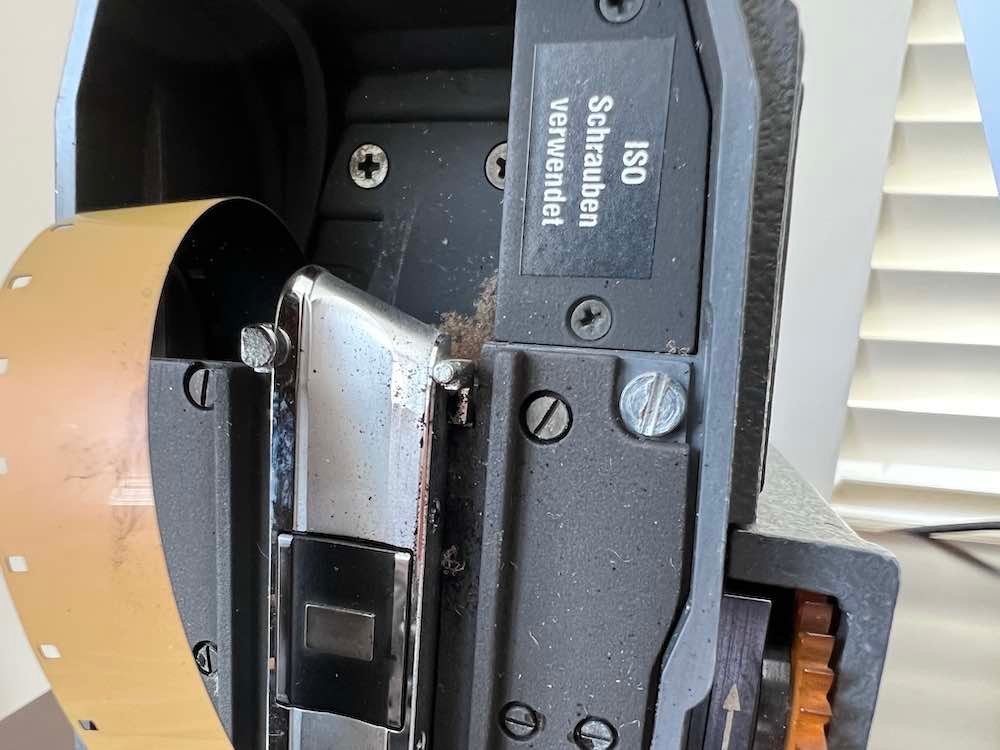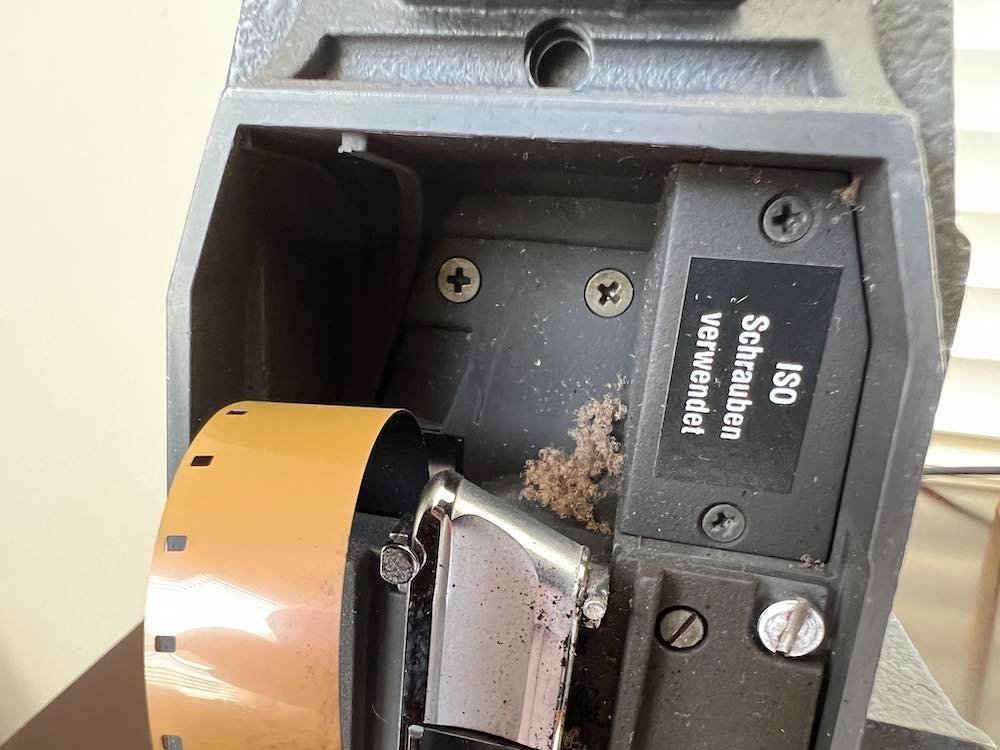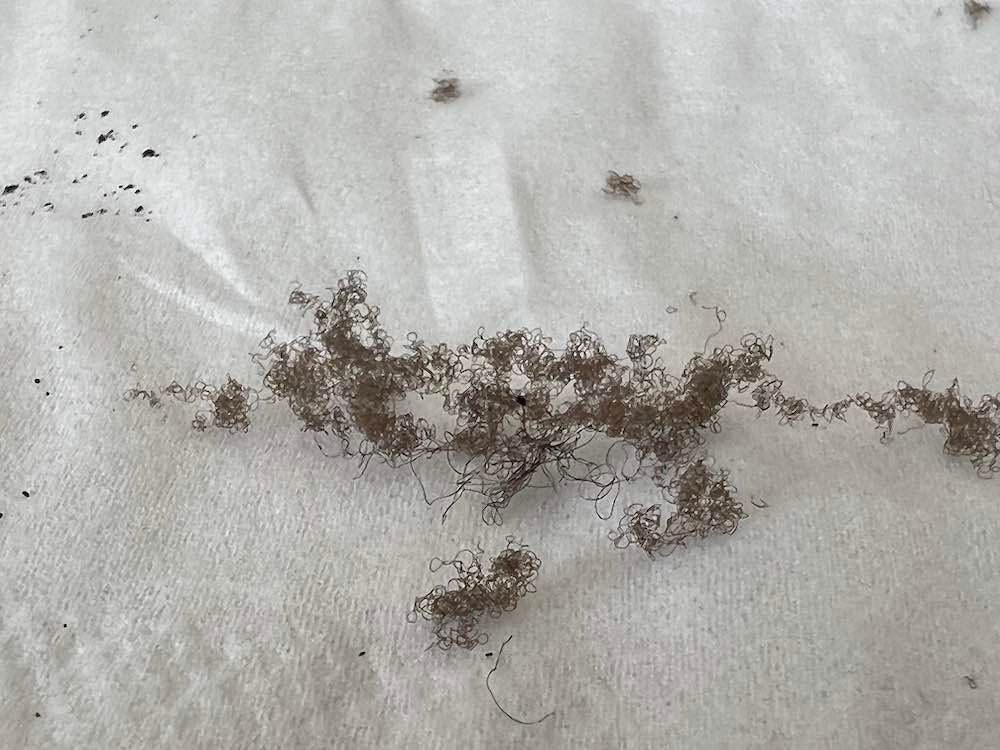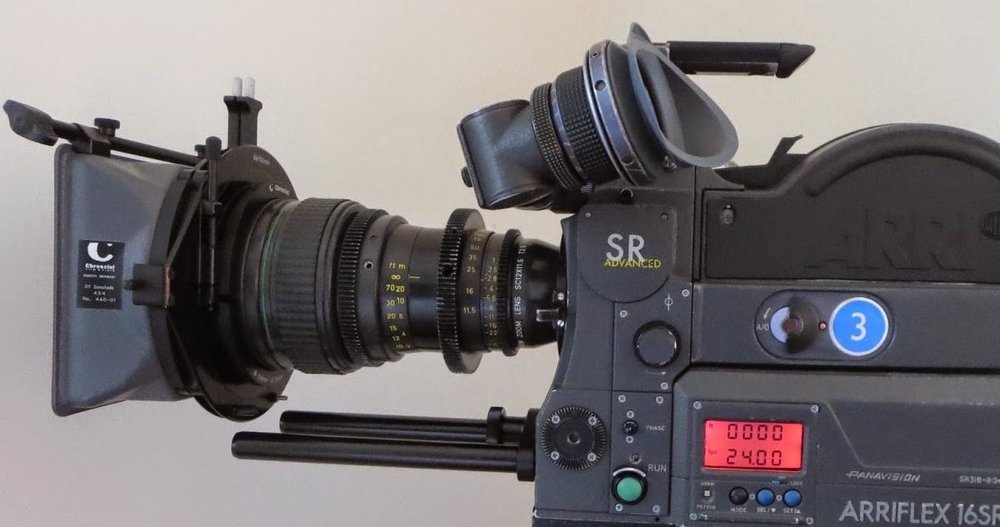-
Posts
104 -
Joined
-
Last visited
Profile Information
-
Occupation
Other
-
Location
Midwest
Recent Profile Visitors
6,594 profile views
-
Hi all. I hadn't had my SR3 fully assembled and running in nearly two years, so I thought I'd get it out, run some practice film through the mags, and put it through its paces...kind of like periodically running a car that is in storage. Anyway, all appears to be well mechanically, but after running 300' or so of practice film through one of the mags, I noticed accumulation of debris in the throat of the mag, and a bit of black sooty material on the pressure plate. The material accumulated in throat seemed to have the consistency of carpet lint, but I'm pretty sure it's extremely thin, curled shavings of film. Any thoughts on whether this indicates an issue with the mag, or could it be simply due to practice film that's past its prime? My practice film is some older EXR, and while I've used it sparingly before (maybe running 30' or so through just to do a scratch test), this time I ran nearly 300' through the mag, and even ran the camera at 48 FPS for a minute. I've never had an issue with this mag before, and I'm hoping that it's just an issue with film that I shouldn't be using anymore, even for testing. On that note, what's the best source for acquiring some new-ish test film? Thanks to anyone who might be able to help!
-
I have a Canon 11.5 - 138 S16 PL mount lens that I use with my SR3, and if possible, I'd like to try some digital cinematography with my S16 lens. A while back I asked about digital cinematography with a S16 lens, and someone mentioned that the BMPCC might be a good choice. I'm guessing that this was referring to the original BMPCC, which was limited to 1080 and had a S16 sensor. Does anyone know if the newer BMPCC 4k would be a viable option, or would its (presumably) larger 4/3" sensor pose issues for using a S16 lens? Or, does the BMPCC 4k have some sort of scaling option that would make the use of a S16 lens possible? I'm guessing that shooting 4k with a S16 lens may not be possible, so I'm curious what the resolution options would be with my lens. Along the same lines, is there particular MFT to PL adapter that's generally regarded as being superior to others? I see that there are a number of adapters available, but as with anything else, my assumption is that you get what you pay for. Without any prior knowledge, I would probably be inclined to go with Wooden Camera's adapter, as I've been pretty impressed with WC gear that I've bought for my SR3 rig. Also, is shimming usually a necessary process when it comes to using this kind of adapter? I notice that Wooden Camera sells an "all purpose" MFT to PL adapter that includes a set of shims, however they also have a MFT to PL adapter advertised as being specifically for the BMPCC that doesn't appear to include shims. That said, I'm curious if these adapters are, in fact, a little different, and if the BMPCC version has been tweaked to ensure optimal compatibility with the BMPCC. Thanks!
-

A Few Questions about TC Slates & TC Editing Workflows
Karl Lee replied to Karl Lee's topic in General Discussion
Right...I can't imagine that there are any systems that can (accurately and consistently) visually resolve TC from a TC slate in a video clip. Rather, I'd imagine that if the TC slate was the primary visual reference, TC would need to be set manually in the NLE for each slated take. -

A Few Questions about TC Slates & TC Editing Workflows
Karl Lee replied to Karl Lee's topic in General Discussion
I should have specified this in my original post, but I'm primarily interested in how this relates to production workflows where the camera itself isn't synced (such as when using a film camera not equipped with Aatoncode / Arricode), in which case the TC slate captured visually on film and the TC-synced audio recorder are the only two reference points for synchronization. -

A Few Questions about TC Slates & TC Editing Workflows
Karl Lee posted a topic in General Discussion
I was curious if anyone might be able to help with a few questions I have about production workflows that use a TC slate for sync sound. While I understand that an external TC generator is used to sync both the TC slate and TC-capable audio recording device, my questions are specifically about how TC on the audio recording device translates to the editing workflow. My understanding is that there are a couple of ways to handle audio TC in double system recording. One method, which seems to be the most widely discussed, is that the TC-synced audio recorder adds a timecode “stamp” to each file to note the exact time at which the recording started. From what I’ve read, .bwf seems to be the most popular file format for TC-stamped audio recordings. Secondly, while this method may not be widely used, another option, on a multi-track recording, would be to record SMPTE timecode (from an external TC generator synced to the slate) on one audio track, thus providing TC reference for the recorded clip by virtue of the SMPTE recorded on a spare audio track. Being mindful of present-day NLE workflows, are both of these TC methods practical, or is one typically preferable over the other? And, for the latter workflow, can most NLEs decode SMPTE timecode from an audio track, or would this need to be done in a third-party program or utility? In particular, I’d be interested to know how these two workflows would translate specifically to DaVinci Resolve or Avid Media Composer | First. It would seem that the second method I mentioned might be a little more helpful in spot checking sync throughout a longer clip, as this method would have a running TC reference for the duration of the audio clip as opposed to a single time stamp that was marked at the beginning of the recording. Any thoughts or information would be appreciated. Thanks! -
Hi everyone. I have an SR3 and a Canon 11.5 - 138 S16 PL mount lens. Out of curiosity, do there exist any digital cinema cameras, past or present, on which a S16 lens would provide sufficient coverage for the sensor at all focal lengths? I'm guessing that 4K is definitely out of the question, and that even 1080p might be iffy, but I thought I'd as least ask. I'm just curious if, in addition to shooting S16, I might be able to use my Canon lens for any digital cinema applications as well, provided that I pair it with the right camera. Thanks!
-
Hi everyone. I'd like to get a follow focus for the Canon 11.5 - 138 S16 lens that I use with my SR3, however I see that there are a few different standards for gear sizes (MOD 0.8, MOD 0.6, and so on), and that even within these standards, there are various tooth counts (MOD 0.8 w/ 35 tooth count, MOD 0.8 w/ 42 tooth count, etc.). Is there any way for me to figure out which "MOD" standard and tooth count would be compatible with my lens? I'm not sure if the gear rings on my lens are factory originals, or if they were added by the original owner (my lens was originally a rental which I purchased from Otto Nemenz). I've included a photo of my lens for reference. From the photo, would anyone be able to make an educated guess as to which follow focus gear I would need for the lens? Thanks to anyone who might be able to help!
-

Help Identifying a Slate / Marker from the 1960s (with photo)...
Karl Lee replied to Karl Lee's topic in General Discussion
This has turned out to be an interesting discussion, and thanks to everyone who has replied to my original thread. I did notice in the screenshot that there appears to be a bit of vignetting around the corners of the slate, so that's why I thought that perhaps there was some sort of optical path integrated into the camera that allowed the internal slate to be filmed. And, if the illumination of the marker (or some other visual cue) and bloop sync tone were synchronized, then I'd assume that the marker must have been filmed during production as either a standard slate or tail slate. Also, could someone explain the difference between ANSI, NISO, and DIN markers? On the surface, the marker just looks like an incrementing counter, so I'm curious about what the difference was between these different types of slates / markers. Thanks! -
Hi everyone. I wanted to see if anyone might be able to help explain a slate / marker that I noticed while watching an episode of The Monkees TV series from the 1960s. Yes, I actually became an avid fan of the show in the late 1980s when I was in first or second grade and the show was airing daily on a local channel. Anyway, this particular episode includes a few outtakes at the end of the show prior to the end credits, and between takes there's a momentary shot of what appears to be some sort of slate or marker, accompanied by an audio cue that's essentially just a buzzing sound (or maybe it's overmodulated tone). As expected, the number increments with each new take. Out of curiosity, does anyone know what type of slate this was? I'm curious if this was actually some sort of slate that was filmed during production (perhaps even integrated into the camera), or if it was inserted at some point in post or during the audio synchronization process. Thanks to anyone who might be able to help!
-
This might be old news, but while I was checking out the S8 section of Kodak's website and reading about their new S8 camera, I noticed that they plan to start offering an all-in-one film/processing/scanning package for S8, presumably to coincide with the release of their new S8 camera. From the website... Easier than Ever Shooting Analogue has never been so easy. When you purchase film you will be buying the film, processing and digital transfer. The lab will send you your developed film back and email you a password to retrieve your digital scans from the cloud so you can edit and share in any way you choose. There's no pricing information yet, but it will certainly be interesting to see how this pans out. Kodak seems to be marketing the new S8 camera under their consumer division, so I'm curious if these will actually be decent quality scans/transfers, or transfers that might be impressive enough for the average consumer but not so much to someone with a more discriminating eye for film transfers. Hopefully the former will be the case. Also, I'm curious if Kodak is establishing their own facility to handle the processing and transfers, or if this is something that will be outsourced. I've read that Kodak will be opening a new film lab in NYC sometime later this year, so perhaps these services will coincide with the opening of their new lab. I've been shooting 16mm for the last couple of years since I bought my SR3, but I shot tons of S8 before I stepped up to 16mm. This might be an excuse to pull the old 7008PRO out of retirement and try shooting some S8 again!
-
No offense taken, Bill. I can certainly see your perspective regarding the deeper DOF and overall crispness of some scenes, and I'm always interested to hear feedback from others. My lens is a Canon 11.5 - 138. I bought it used, and I'm not quite sure when Canon made this particular lens, but it's specified as a S16 lens, so my guess is probably late '90s or early 2000s. It's not nearly as expensive as a Cooke or Zeiss, but I didn't want to put too much money into a much more expensive lens since this is more less a hobby for me...and I already put enough into buying the SR3! Even so, I've been quite pleased with the lens, considering that I was able to stay under $2500 for a pre-owned PL mount zoom. On a side note, in an earlier post Gregg indirectly mentioned something about the possibility of UV (presumably since it was a sunny day) resulting in less contrast. Under what circumstances would the use of a UV filter be recommended? I don't have any UV filters at the moment, although I was thinking of picking up one at some point to use as an optical flat in my matte box for lens protection if I'm not using any other filters.
-
Bill, I was using a ND9 when I was shooting 250D in Chicago, and no filter when I was shooting 50D in Toronto and Ottawa. I checked my notes, and with a couple of exceptions, I filmed most of the shots in Toronto and Ottawa at a T5.6 / 8 split (50D / no filter). In Chicago, I filmed most of the shots in direct sunlight at T11, while most shots with mixed sun / shadows were filmed at a T5.6 / 8 split or T8 (250D with ND9). That said, perhaps the narrower apertures and resulting deeper DOF are contributing to your observations. Also, many shots were filmed with my lens at its widest (11.5 mm), so that combined with the narrower aperture did result in a deeper DOF. Generally speaking, when filming exteriors as I did in my uploaded videos, are narrower apertures like T8 or T11 used frequently, or do most cinematographers prefer filtering down to maybe a T2.8 or T4, even on a sunny day to achieve a shallower DOF? There are many variables and I'm sure it all depends on the situation and desired look, but maybe next time I'll give it a try. Focus will be a little more critical, but I wouldn't mind experimenting with a shallower DOF. You hear about trying to make video look like film all the time, but I guess trying to make film look like film can sometimes be an issue as well!
-
Thanks for the notes and replies. As some of you have already mentioned, I think some of the quality and grain is definitely lost in the YouTube compression. I actually tried exporting a variety of different formats from Premiere and and uploading them to YouTube, but I found that even the higher resolution files ultimately succumb to YouTube's transcoding and compression. Bill, to my eyes grain is much more evident in the original ProRes clip I received from FotoKem, but moreso in the 250D than the 50D which is what I would have expected. As I mentioned, I think the YouTube compression has killed some of the grain detail. Out of curiosity, when you mentioned that it looks a bit too "crisp", are you referring to the lack of grain, or is there something else about the filming and/or transfer that might be making it a little too crisp in your opinion? I don't know exactly which equipment FotoKem used for the transfer, so I'm not sure if it was technically a telecine or scan transfer. The end product, as I requested, was a ProRes 4444 clip, so I don't have discrete, individual frames from a scan. Even so, if you're curious I could try uploading a few snippets of my transfers to Dropbox and make them available for download. I think ProRes is pretty much out of the question on account of its size, but I could experiment with a few different formats. Yes, my project was just processing and transfer for 800' of S16, and they were very accommodating and happy to help.
-
Well, I'm a little late (ok...really late!), but I just wanted to give a shout out to FotoKem for a really nice S16 processing and transfer job they did for me late last year. I finally got around to uploading a few samples of my filming in Chicago, Toronto, and Ottawa which I thought I'd share, since I know many of us are curious about how others' transfers have turned out. I'm really happy with the transfer, and I think FotoKem's work added a nice, crisp look to my otherwise rudimentary camera work.
-
On the SR3, just above the pitch adjustment on the dumb side of the camera, there's a mounting bracket for the IVS video tap. Does anyone know if this bracket is some kind of standard ARRI mount, and if so, what it's called? My SR3 package came with an IVS video tap, but since I rarely use the tap I usually just keep it detached from the camera to cut down on weight. With the IVS removed, the mounting bracket would be very convenient for attaching an accessory or two, but I can't seem to find any information about this bracket. I checked, and it's a little wider than a standard hot shoe mount, so unfortunately I can't use any of the readily available hot shoe mounts or adapters. I could probably rig up something on my own, but I thought I'd check here first. Thanks!







